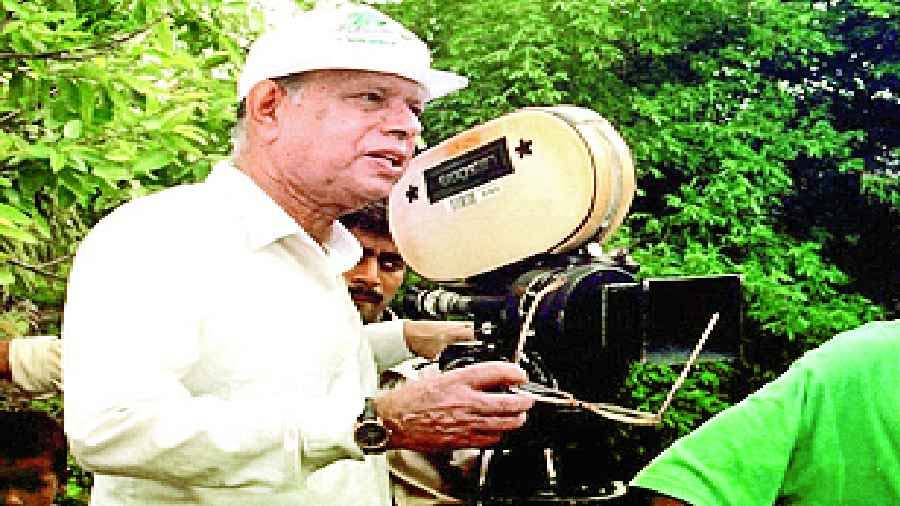Tirthankar Mitra
One can recall few Bengali film makers other than Tapan Sinha who made the process of building a bridge between a well directed film and cash boxes jingling merrily at the theatres look so easy. The birth anniversary of this physics post graduate who learnt the rudiments of film shooting at Pinewood Studios, England and matured into an ace film maker, passed by on October 2.
Almost each and every one of Sinha’s films was eagerly looked forward to. Be it Jhinder Bandi or Safed Hathi, sight of a serpentine queue was a sure shot indication of a Sinha film running at a theatre which showed Bengali films.
There was a well crafted storyline with a turn for speed though it seldom brought the viewers at the edge of his/her seat. Almost every Sinha film made pleasant viewing. There were no repetition of plots. Nor were there any sequels.
Sinha was acutely aware of the issues of times which he turned into the plots for his films. Be it marital discord leading to dissolution of marriage after the relation has turned into a tinder box( Jatugriha), the trauma of a teacher who has witnessed a murder (Atanka), a smiling domestic help pouring oil over troubled waters of a household in turmoil (Galpo Holeo Sotti), interactions between a young man, four widows and a young maiden on a visit to Puri (Nirjan Saikate), a search for an albino elephant ( Safed Hathi) are a few of the plots of Sinha’s films.
Yet awards never rained on Sinha’s films in the manner it did on the works in celluloid of a few of his peers and juniors. It needs to be mentioned that most of these much acclaimed films of the latter tribe stumbled and fell at the box office. Theirs were an invariably short run at the movie theatre. But more often than not, it was these films young men and women debated and discussed and some critics waxed eloquent.
Comparisons are invariably drawn between Sinha’s films and those of the triumvirate from Bengali cinema, Satyajit Ray, Mrinal Sen and Ritwik Ghatak. If Sinha’s films were never considered at par with the works on celluloid of this illustrious troika, it did not bother the director. His works were respected by a large number of film experts whose verdicts in the matter of films were considered infallible. Moreover, it was no small consolation to Sinha that his films enjoyed a larger audience.
The reason of Sinha not being in a league with Ray, Sen and Ghatak was an image tried to be imposed on him that his ideas were against the common man and class struggle. The campaigners had based their contention on the film Sagina Mahato starring Dilip Kumar enacting the role of a trade union leader in a tea garden in which he becomes a victim of intra-party intrigue. There was a raging debate in Calcutta’s cine circles about the ideological content of the Sinha film.. But the director was happy that his film as liked by the common viewers and it was a box office hit.
Atankaand Antardhan, both films dealing with incidents of deterioration of the law and order situation in West Bengal had come out in print further fuel the disinformation campaign against Sinha. He could not care less. For Sinha knew that his audience was only too aware of the actual state of things. His films would have flopped had his fans believed in the canards.
Sinha’s was an effort in celluloid to depict the endeavour of an individual to rise in protest and set right the injustices spewing forth from an out of sync administrative system. Sinha’s critics were the recipients of fishes and loaves from this system.
Be it a golden hearted doctor enacted by Ashok Kumar in Hate Bazare dying to save the honour of a young widow essayed by Vyjayantimala or a kidnapped prince being doubled by a look alike commoner in Jhinder Bandi who is heartbroken to leave his beloved princess betrothed to the abducted royal who has been rescued, individuals continued to be the heroes of Sinha’s films. He had made a casting coup in this film in which Uttam Kumar and Soumitra Chattopadhyay shared screen space for the first time.
Vast and varied story lines are part of his oeuvre in showing trials and travails of youth going astray(Apanjan), fight of a father for justice of his daughter who has been raped(Adalat O EktiMeye), a fruit seller Afghan’s love for a little girl in Bengal as he pines for his daughter left behind in his mountainous village (Kabuliwala), plight of a riverside community ( Hansuli Banker Upakatha) and an elephant(Ankush) Sinha’s debut film more than prove his mettle as a filmmaker. Even in Ek Doctor Ki Mauth, directed much later in his career which was based on a contemporary topic in whose portrayal he did not mind rubbing the powers that be in the wrong way.
All that mattered to Sinha was the taste of his audience and he knew the point of time when it sought a change. And the couples who had watched Jatugriha and yet cemented their marriage returned decades later to be captivated by Bancharamer Bagan to see how a green fingered farmer stood up to a zamindar to protect the greens he had planted but had pledged to be returned to its original owner on his passing.
Sinha had the Midas touch. His films became hits no matter whether non-entities or matinee idols and screen sirens were cast in them. What set him apart from the other film makers? It was Sinha’s nonchalant mastery of springing surprises pleasant and otherwise on the screen. (IPA)


